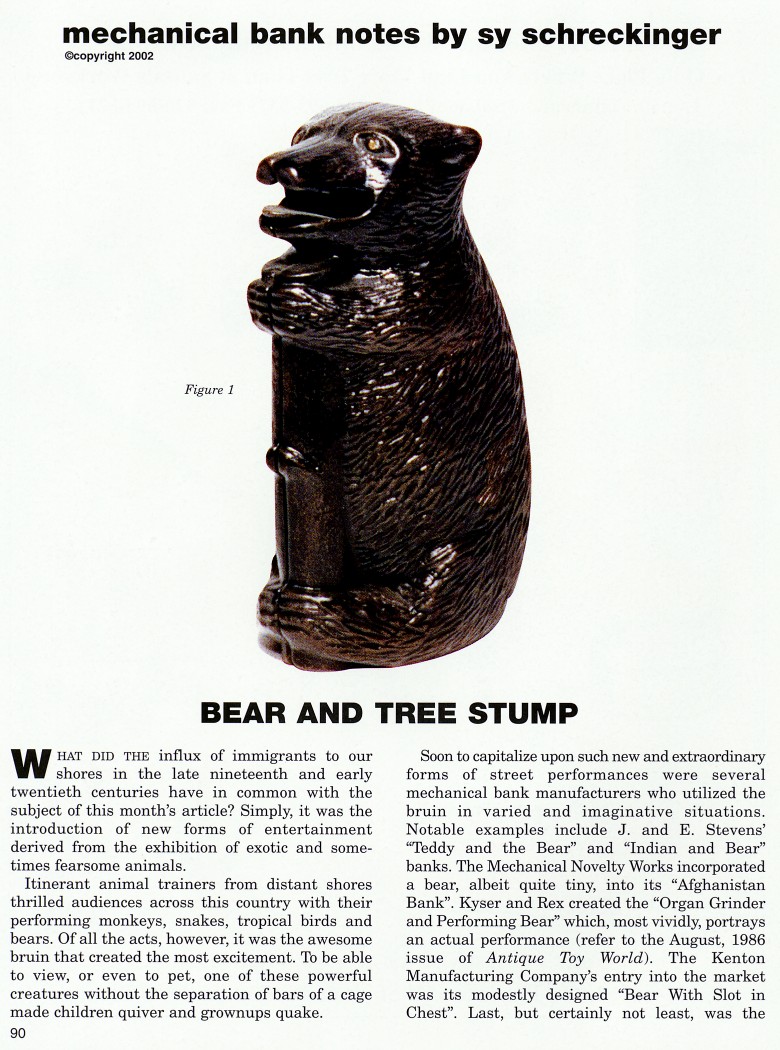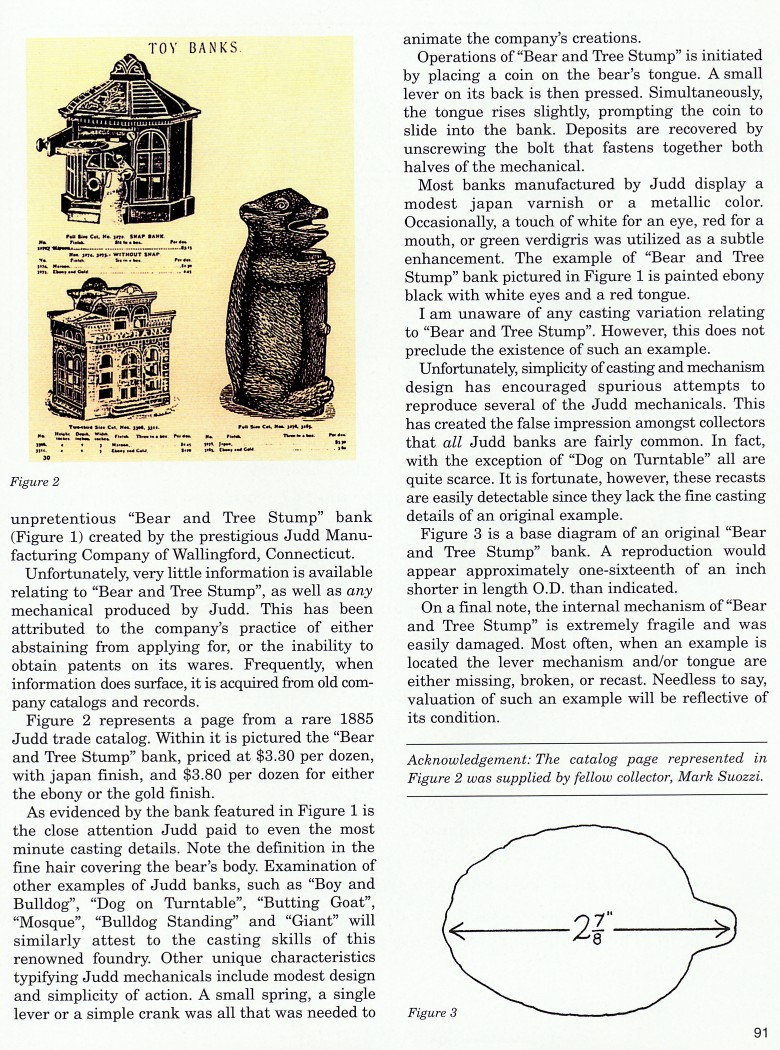|
Bear and Tree Stump
by Sy Schreckinger – ANTIQUE TOY WORLD Magazine – October, 2002
What did the influx of immigrants to our shores
in the late nineteenth and early twentieth centuries have in common with
the subject of this month's article? Simply, it was the introduction of
new forms of entertainment derived from the exhibition of exotic and
sometimes fearsome animals.
Itinerant animal trainers from distant shores thrilled audiences
across this country with their performing monkeys, snakes, tropical birds
and bears. Of all the acts, however, it was the awesome bruin that created
the most excitement. To be able to view, or even to pet, one of these
powerful creatures without the separation of bars of a cage made children
quiver and grownups quake.
Soon to capitalize upon such new and extraordinary forms of street
performances were several mechanical bank manufacturers who utilized the
bruin in varied and imaginative situations. Notable examples include J.
and E. Stevens' "Teddy and the Bear" and "Indian and Bear" banks. The
Mechanical Novelty Works incorporated a bear, albeit quite tiny, into its
"Afghanistan Bank". Kyser and Rex created the "Organ Grinder and
Performing Bear" which, most vividly, portrays an actual performance
(refer to the August, 1986 issue of Antique Toy World). The Kenton
Manufacturing Company's entry into the market was its modestly designed
"Bear With Slot in Chest". Last, but certainly not least, was the unpretentious "Bear and Tree Stump" bank (Figure 1)
created by the prestigious Judd Manufacturing Company of Wallingford,
Connecticut.
Unfortunately, very little information is available relating to "Bear
and Tree Stump", as well as
any mechanical produced by Judd. This has been
attributed to the company's practice of either abstaining from applying
for, or the inability to obtain patents on its wares. Frequently, when information does surface, it is acquired from old company catalogs and
records.
Figure 2 represents a page from a rare 1885 Judd trade catalog.
Within it is pictured the "Bear and Tree Stump" bank, priced at $3.30 per
dozen, with japan finish, and $3.80 per dozen for either the ebony or the
gold finish.
As evidenced by the bank featured in Figure 1 is the close attention
Judd paid to even the most minute casting details. Note the definition in
the fine hair covering the bear's body. Examination of other examples of
Judd banks, such as "Boy and Bulldog", "Dog on Turntable", "Butting Goat",
"Mosque", "Bulldog Standing" and "Giant" will similarly attest to the
casting skills of this renowned foundry. Other unique characteristics
typifying Judd mechanicals include modest design and simplicity of action.
A small spring, a single lever or a simple crank was all that was needed
to animate the company's creations.
Operations of "Bear and Tree Stump" is initiated by placing a coin on
the bear's tongue. A small lever on its back is then pressed.
Simultaneously, the tongue rises slightly, prompting the coin to slide
into the bank. Deposits are recovered by unscrewing the bolt that fastens
together both halves of the mechanical.
Most banks manufactured by Judd display a modest japan varnish or a
metallic color. Occasionally, a touch of white for an eye, red for a
mouth, or green verdigris was utilized as a subtle enhancement. The
example of "Bear and Tree Stump" bank pictured in Figure 1 is painted
ebony black with white eyes and a red tongue.
I am unaware of any casting variation relating to "Bear and Tree
Stump". However, this does not preclude the existence of such an example.
Unfortunately, simplicity of casting and mechanism design has
encouraged spurious attempts to reproduce several of the Judd mechanicals.
This has created the false impression amongst collectors that all Judd
banks are fairly common. In fact, with the exception of "Dog on Turntable"
all are quite scarce. It is fortunate, however, these recasts are easily
detectable since they lack the fine casting details of an original
example.
Figure 3 is a base diagram of an original "Bear and Tree Stump" bank.
A reproduction would appear approximately one-sixteenth of an inch shorter
in length O.D. than indicated.
On a final note, the internal mechanism of "Bear and Tree Stump" is
extremely fragile and was easily damaged. Most often, when an example is
located the lever mechanism and/or tongue are either missing, broken, or
recast. Needless to say, valuation of such an example will be reflective
of its condition.
Acknowledgement: The catalog page represented in Figure 2 was
supplied by fellow collector, Mark Suozzi.
Addendum: (from
December, 2002) My apologies for omission of acknowledgement of the "Bear
and Tree Stump Bank" featured in the
October 2002 issue of Antique Toy
World. The fine example shown in the article is in the collection of Steve
and Marilyn Steckbeck.
|


